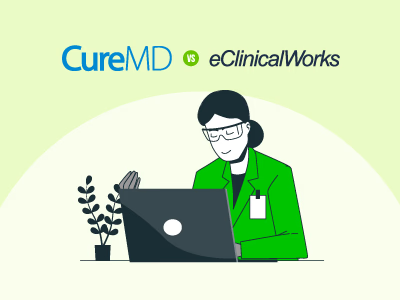Choosing the right EHR software can make or break a healthcare practice’s daily workflow. From appointment scheduling to patient records, a user-friendly system saves time, reduces errors, and boosts staff efficiency.
That’s where CureMD and eClinicalWorks come into the picture. Both are well-known names in the healthcare IT space, but each offers a different usability experience. For practices exploring their options, understanding these differences can be a game-changer.
This blog compares CureMD and eClinicalWorks to help you determine which software is more user-friendly and better suited for your needs.

CureMD is a cloud-based EHR solution tailored for various specialties, including cardiology, dermatology, and internal medicine. It is particularly recognized for its integrated practice management and patient portal tools. CureMD also offers iPad compatibility, allowing for mobility during patient encounters.

eClinicalWorks is a cloud-based EHR and practice management system used across several specialties, including primary care and urgent care settings. It's well known for its healow suite and customizable templates that adapt to different workflows. Its support for mobile access and patient engagement tools stands out.

Feature | CureMD | eClinicalWorks |
Cloud Access | ✓ | ✓ |
Document Management | ✓ | ✓ |
Medical Billing | ✓ | ✓ |
Telehealth | ✓ | ✓ |
Reporting | ✓ | ✓ |
Scheduling | ✓ | ✓ |
Integration | ✓ | ✓ |
Compliance | ✓ | ✓ |
Mobile Access | ✓ | ✓ |
Support Options | ✓ | ✓ |
| PROS | PROS |
|
|
| CONS | CONS |
|
|
CureMD users often praise the system's comprehensive features, including its seamless integration of EHR and billing services. Many appreciate its intuitive interface and customizable tools that support efficient clinical workflows. However, recurring complaints revolve around the learning curve and delayed customer support responses, which some users find frustrating during onboarding.
Meanwhile, eClinicalWorks is frequently commended for its robust functionality and value-driven pricing. Users highlight the extensive customization options and built-in tools for population health and patient engagement. Still, several reviewers mention occasional system glitches and a complex interface that may require additional training for new users.
Ultimately, both CureMD and eClinicalWorks offer feature-rich solutions that cater to different priorities. While CureMD may appeal to practices looking for streamlined billing integration, eClinicalWorks suits those prioritizing deep customization and scalable tools. The final decision depends on each organization’s unique needs, budget, and comfort with the software’s learning curve.
CureMD and eClinicalWorks both offer powerful tools for medical practices, but they cater to slightly different priorities. CureMD is well-suited for practices looking for a unified platform with customizable care management tools and seamless billing services. On the contrary, eClinicalWorks offers a more scalable solution with in-depth population health features and affordable subscription plans for practices of various sizes.
When selecting between the two, practices should consider pricing, usability, integrations, and long-term support. A solution that fits your existing workflow and reduces administrative friction will likely deliver better outcomes in the long run.
